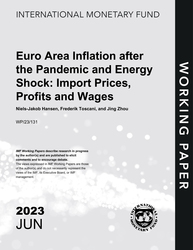
Euro Area Inflation after the Pandemic and Energy Shock: Import Prices, Profits and Wages
Euro Area Inflation after the Pandemic and Energy Shock: Import Prices, Profits and Wages
READ MORE...
Volume/Issue:
Volume 2023
Issue 131
Publication date: June 2023
ISBN: 9798400245473
$20.00
Add to Cart by clicking price of the language and format you'd like to purchase
Available Languages and Formats
| English |
Prices in red indicate formats that are not yet available but are forthcoming.
Topics covered in this book
This title contains information about the following subjects.
Click on a subject if you would like to see other titles with the same subjects.
Inflation , Labor , Economics- Macroeconomics , Economics / General , Inflation , Wages , Profits , Terms of Trade , novel consumption deflator decomposition , profit share , profit projection , deflator inflation , growth space , Deflation , Consumption , Labor costs , Europe , North America , Global
Summary
We document the importance of import prices and domestic profits as a counterpart to the recent increase in euro area inflation. Through a novel consumption deflator decomposition, we show that import prices account for 40 percent of the average change in the consumption deflator over 2022Q1 – 2023Q1, while domestic profits account for 45 percent. The increase in nominal profits was largest in sectors benefiting from increasing international commodity prices and those exposed to recent supply-demand mismatches. While the results show that firms have passed on more than the nominal cost shock, and have fared relatively better than workers, the limited available data does not point to a widespread increase in markups. Looking ahead, assuming nominal wage growth of around 4.5 percent over 2023-24 – slightly below the level seen in Q1 2023 – and broadly unchanged productivity, a normalization of the profit share to the average level over 2015-19 will be necessary to achieve a convergence of inflation to target over the next two years. Monetary policy will thus need to remain restrictive to anchor expectations and maintain subdued demand such that workers and firms settle on relative price setting that is consistent with disinflation.
Copyright © 2010 - 2025
Powered by:
AIDC



